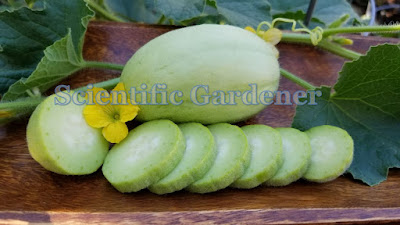Back in 2017, I happened upon a Facebook post by an organization called Biodiverso di Puglia about a farmer named Luigi, who had discovered a new type of cucumber-melon. One day, in the course talking with some family friends about the importance of safeguarding Salento’s agricultural biodiversity, Luigi’s friends told him that in their father’s home in the countryside of Sogliano, they had some seeds of a variety of cucumber-melon that their father grew. The father, Uccio, had kept and maintained a population of cucumber-melons year after year until he passed away. While it was fortunate that had left a small box with a number of jars containing the seeds, the seeds were already 15 years old.
Upon receiving the seeds, Luigi sowed them all. That was back in 2016. Out of those seeds, only one plant of what Luigi called the white Pupuneddhra, or Pupuneddhra bianca grew. For context, depending on the local dialect, Puglian farmers call melons that are picked immature as cucumbers by a variety of names. While they are generally referred to as carosello by seed companies, they are also called meloncella, cucumbarazzi, spuredda, and Pupuneddhra. Luigi ate one fruit and left the other as a what they call in the local dialect “samentara” or a fruit reserved for seed.
After years of hoping, I was blessed to receive some of these white cucumber-melons from Luigi in early 2022. While the germination rate was relatively low, he had provided enough seed for me to coax the remainder of the poor seed to become healthy seedlings. The seedlings were cared for and planted, and after some adverse conditions related to the soil and critters ran their course, I planted a second round of seedlings to fill in the spots left by the plants that didn’t make it.
The variety grew well. From the beginning, previous pictures that Luigi had shared led me to believe that the variety would be polymorphic – meaning that the vines would produce a number of fruit shapes, sizes and colors. As the fruit began to set on the vine, I culled (or removed from the population) vines whose fruit were not at least partially white. I continued to pull vines until all the plants had at least set fruit long enough for me to decipher the fruit color and remove all unwanted vines. I then harvested all of the white fruit, leaving the desired vines that had set prior to distinguishing the color of neighboring dark fruit. From the entire next crop of white fruit, except for the misshapen ones, I produced my own “samentara” or fruit reserved for seed.
The fruit itself had a very nice smooth texture. The variety was about as watery as a young Tortarello Barese (also known as a dark Snake Melon or Armenian Cucumber). It was more watery than a zucchini but less juicy than a lemon cucumber - somewhere between a Carosello Mezzo Lungo Barese and a Carosello Bianco Lecce.
Typically, when I am gifted a new cucumber-melon variety that I am able to grow out to seed, I send an extra portion of fresh seed back to those who gave the initial seed to me. This is a practice I have adopted over the years to thank those who entrust me with their precious indigenous cucumber-melon varieties. While I am never able to fully repay the kindness of those who share seed with me, I have returned a large quantity of fresh healthy Pupueneddhra bianca seed back to Luigi. Thanks to his efforts, this white cucumber-melon that originated with Uccio of Sogliano will not be forgotten.





























































